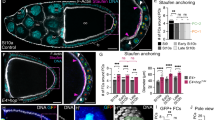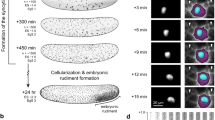Abstract
The segmental pattern of insect embryos depends on influences from morphogenetic centres near each of the egg poles1. In Drosophila, maternal effect mutations are known that impair the normal function of each centre2. Injection of wild-type cytoplasm into mutant eggs has revealed that morphogenetic signals localized at the anterior and posterior pole of eggs can be transplanted3,4. We show here that these activities can also be detected during oogenesis. Posterior activity can be recovered at an early stage (stage 10, ref. 5) from the oocyte-nurse cell complex, but anterior activity can only be detected in the mature oocytes (stage 14). We conclude that the bicoid-dependent anterior signal, although produced by the nurse cells, does not become active before it is localized to the anterior egg pole, whereas posterior activity can be detected in the nurse cells before, and therefore independently of, its localization to the posterior egg pole.
This is a preview of subscription content, access via your institution
Access options
Subscribe to this journal
Receive 51 print issues and online access
$199.00 per year
only $3.90 per issue
Buy this article
- Purchase on Springer Link
- Instant access to full article PDF
Prices may be subject to local taxes which are calculated during checkout
Similar content being viewed by others
References
Sander, K. Adv. insect. Physiol 12, 125–258 (1976).
Nüsslein-Volhard, C., Frohnhöfer, H. G. & Lehmann, R. Science 238, 1675–1681 (1987).
Lehmann, R. & Nüsslein-Volhard, C. Cell 47, 141–152 (1986).
Frohnhöfer, H. G. & Nüsslein-Volhard, C. Nature 324, 120–125 (1986).
King, R. C. Ovarian Development in Drosophila melanogaster (Academic, New York, 1970).
Bohrmann, J. & Sander, K. Wilhelm Roux Arch. dev. Biol. 196, 279–285 (1987).
Gutzeit, H. O. & Koppa, R. J. Embryol. exp. Morph. 67, 101–111 (1982).
Frohnhöfer, H. G., Lehmann, R. & Nüsslein-Volhard, C. J. Embryol. exp. Morph. 97, 169–179 (1986).
Bull, A. J. Expl. Zool. 161, 221–242 (1966).
Nüsslein-Volhard, C. Wilhelm Roux Arch. dev. Biol. 183, 249–268 (1977).
Mohler, J. & Wieschaus, E. Genetics 112, 803–822 (1985).
Frigerio, G., Burri, M., Bopp, D. Baumgartner, S. & Noll, M. Cell 47, 735–746 (1986).
Berleth, T. et al. EMBO J. 7, 1749–1756 (1988).
Driever, W. & Nüsslein-Volhard, C. Cell 54, 83–93 (1988).
Mahowald, A. P. J. Expl. Zool. 151, 201–215 (1962).
Schüpbach, T. & Wieschaus, E. W. Wilhelm Roux Arch. dev. Biol. 191, 302–317 (1986).
Boswell, R. E. & Mahowald, A. P. Cell 43, 97–104 (1985).
Robb, J. A. J. Cell. Biol. 41, 876–885 (1969).
Lohs-Schardin, M., Cremer, C. & Nüsslein-Volhard, C. Devl Biol. 73, 239–255 (1979).
Author information
Authors and Affiliations
Rights and permissions
About this article
Cite this article
Sander, K., Lehmann, R. Drosophila nurse cells produce a posterior signal required for embryonic segmentation and polarity. Nature 335, 68–70 (1988). https://doi.org/10.1038/335068a0
Received:
Accepted:
Published:
Issue Date:
DOI: https://doi.org/10.1038/335068a0
This article is cited by
-
Genome reorganization from polyteny to polyploidy in the nurse cells found in onion fly (Delia antiqua) and cabbage root fly (Delia radicum) ovaries (Diptera, Anthomyiidae)
Chromosome Research (1995)
-
A comparison of transplantable bicoid activity and partial bicoid homeobox sequences in several Drosophila and blowfly species (Calliphoridae)
Roux's Archives of Developmental Biology (1993)
-
Morphogenesis of accessory nuclei during final stages of oogenesis in Cosmoconus meridionator (Hymenoptera: Ichneumonidae)
Roux's Archives of Developmental Biology (1993)
-
In vitro culture ofDrosophila ovarian follicles: The influence of different media on development, RNA synthesis, protein synthesis and potassium uptake
Roux's Archives of Developmental Biology (1991)
-
Cytoplasmic factors determining anteroposterior polarity in Drosophila embryos
Roux's Archives of Developmental Biology (1990)
Comments
By submitting a comment you agree to abide by our Terms and Community Guidelines. If you find something abusive or that does not comply with our terms or guidelines please flag it as inappropriate.



